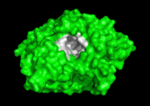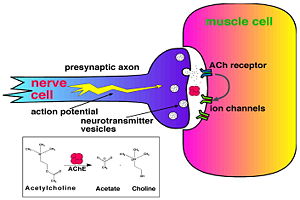Acetylcholinesterase
From Proteopedia
(Difference between revisions)
| Line 45: | Line 45: | ||
The active site of <scene name='1zgb/Com_view/1'>TcAChE</scene> consists of <scene name='1zgb/Act_site/3'>two binding subsites</scene>. First of them is the "catalytic anionic site" ('''CAS'''), which involves mentioned above [http://en.wikipedia.org/wiki/Catalytic_triad catalytic triad] <scene name='1zgb/Act_site/8'>Ser200, His440, and Glu327</scene> <span style="color:orange;background-color:black;font-weight:bold;">(colored orange)</span> and the [http://en.wikipedia.org/wiki/Conserved_sequence#Conserved_protein_sequences_and_Structures conserved residues] <scene name='1zgb/Act_site/5'>Trp84</scene> and <scene name='1zgb/Act_site/10'>Phe330</scene> also participating in ligands recognition. Another conserved residue <scene name='1zgb/Act_site/11'>Trp279</scene> <span style="color:cyan;background-color:black;font-weight:bold;">(colored cyan)</span> is situated at the second binding subsite, termed the "peripheral anionic site" ('''PAS'''), ~14 Å from '''CAS'''. Therefore, the ligands that will be able to interact with both these subsites, will be more potent [http://en.wikipedia.org/wiki/Acetylcholinesterase_inhibitor AChE inhibitors] in comparison to compounds interacting only with CAS (mentioned in the previous section "The first generation of AD drugs - monovalent AChE inhibitors"). One of the ways to produce such ligands is to introduce two active substances into one compound. If it is spatially necessary these subunits could be divided by alkyl linker with suitable length. For example, according to the strategy of the use of a bivalent ligand, the <scene name='1zgb/Comp/7'>inhibitor</scene> '''(''RS'')-(±)-tacrine-(10)-hupyridone''' ((R)-3 or (S)-3) was designed and synthesized. It consists of mentioned above <scene name='1zgb/Comp/8'>tacrine</scene> <font color='magenta'><b>(colored magenta)</b></font>, 10-carbon <scene name='1zgb/Comp/9'>linker</scene> <span style="color:yellow;background-color:black;font-weight:bold;">(yellow)</span>, and <scene name='1zgb/Comp/10'>hupyridone</scene> <font color='red'><b>(red)</b></font>. The tacrine moiety of this inhibitor binds at the CAS, the linker spans the <scene name='1zgb/Act_site/12'>active-site</scene> gorge, and the hupyridone moiety binds at the PAS ([[1zgb]]) <ref name="Haviv">PMID:16076210</ref>. There are also only PAS-binding AChE inhibitors, <scene name='2j3q/Active_site/6'>Thioflavin T</scene> <font color='magenta'><b>(magenta)</b></font> is a good example of them. <scene name='2j3q/Active_site/7'>Superposition</scene> of the crystal structure of the <font color='red'><b>edrophonium</b></font>/''Tc''AChE (CAS-binding inhibitor) ([[2ack]]) on the <font color='magenta'><b>thioflavin T</b></font>/''Tc''AChE complex structure ([[2j3q]]) shows that these ligands' positions do not overlap. Of note is that Phe330, which is part of the CAS, is the single residue interacting with <font color='magenta'><b>thioflavin T</b></font>. This residue is the only one which significantly <scene name='2j3q/Active_site/9'>changes its conformation</scene> to avoid clashes in comparison to other CAS residues of the <font color='red'><b>edrophonium</b></font>/''Tc''AChE complex <ref name="Ravelli">PMID:10089512</ref> <ref name="Sonoda">PMID:18512913</ref>. | The active site of <scene name='1zgb/Com_view/1'>TcAChE</scene> consists of <scene name='1zgb/Act_site/3'>two binding subsites</scene>. First of them is the "catalytic anionic site" ('''CAS'''), which involves mentioned above [http://en.wikipedia.org/wiki/Catalytic_triad catalytic triad] <scene name='1zgb/Act_site/8'>Ser200, His440, and Glu327</scene> <span style="color:orange;background-color:black;font-weight:bold;">(colored orange)</span> and the [http://en.wikipedia.org/wiki/Conserved_sequence#Conserved_protein_sequences_and_Structures conserved residues] <scene name='1zgb/Act_site/5'>Trp84</scene> and <scene name='1zgb/Act_site/10'>Phe330</scene> also participating in ligands recognition. Another conserved residue <scene name='1zgb/Act_site/11'>Trp279</scene> <span style="color:cyan;background-color:black;font-weight:bold;">(colored cyan)</span> is situated at the second binding subsite, termed the "peripheral anionic site" ('''PAS'''), ~14 Å from '''CAS'''. Therefore, the ligands that will be able to interact with both these subsites, will be more potent [http://en.wikipedia.org/wiki/Acetylcholinesterase_inhibitor AChE inhibitors] in comparison to compounds interacting only with CAS (mentioned in the previous section "The first generation of AD drugs - monovalent AChE inhibitors"). One of the ways to produce such ligands is to introduce two active substances into one compound. If it is spatially necessary these subunits could be divided by alkyl linker with suitable length. For example, according to the strategy of the use of a bivalent ligand, the <scene name='1zgb/Comp/7'>inhibitor</scene> '''(''RS'')-(±)-tacrine-(10)-hupyridone''' ((R)-3 or (S)-3) was designed and synthesized. It consists of mentioned above <scene name='1zgb/Comp/8'>tacrine</scene> <font color='magenta'><b>(colored magenta)</b></font>, 10-carbon <scene name='1zgb/Comp/9'>linker</scene> <span style="color:yellow;background-color:black;font-weight:bold;">(yellow)</span>, and <scene name='1zgb/Comp/10'>hupyridone</scene> <font color='red'><b>(red)</b></font>. The tacrine moiety of this inhibitor binds at the CAS, the linker spans the <scene name='1zgb/Act_site/12'>active-site</scene> gorge, and the hupyridone moiety binds at the PAS ([[1zgb]]) <ref name="Haviv">PMID:16076210</ref>. There are also only PAS-binding AChE inhibitors, <scene name='2j3q/Active_site/6'>Thioflavin T</scene> <font color='magenta'><b>(magenta)</b></font> is a good example of them. <scene name='2j3q/Active_site/7'>Superposition</scene> of the crystal structure of the <font color='red'><b>edrophonium</b></font>/''Tc''AChE (CAS-binding inhibitor) ([[2ack]]) on the <font color='magenta'><b>thioflavin T</b></font>/''Tc''AChE complex structure ([[2j3q]]) shows that these ligands' positions do not overlap. Of note is that Phe330, which is part of the CAS, is the single residue interacting with <font color='magenta'><b>thioflavin T</b></font>. This residue is the only one which significantly <scene name='2j3q/Active_site/9'>changes its conformation</scene> to avoid clashes in comparison to other CAS residues of the <font color='red'><b>edrophonium</b></font>/''Tc''AChE complex <ref name="Ravelli">PMID:10089512</ref> <ref name="Sonoda">PMID:18512913</ref>. | ||
| - | ==== | + | ==== Galantamine ==== |
Described above, <scene name='1w4l/Al/1'>Galantamine</scene> (abbreviated as <scene name='1w4l/Al/2'>GAL</scene>; <font color='red'><b>colored red</b></font>) is a CAS-binding inhibitor and it is currently used in therapy of [[Alzheimer's Disease]] under the trade name [[Razadyne]]. Conjugate of GAL through the <scene name='1w4l/Al/3'>alkyl linker</scene> (<span style="color:yellow;background-color:black;font-weight:bold;">8 carbons, yellow</span>) with a <scene name='1w4l/Al/4'>phthalimido moiety</scene> <font color='blueviolet'><b>(blueviolet)</b></font> called '''compound 3''' has a larger affinity for AChE than that of GAL alone. This is similar to previously described cases of bivalent ligands (''e.g.'' '''(''RS'')-(±)-tacrine-(10)-hupyridone'''). A comparison between <scene name='1w4l/Comparison/1'>compound 3</scene>/''Tc''AChE ([[1w4l]]) and <scene name='1w4l/Comparison/2'>galanthamine/TcAChE</scene> structure ([[1dx6]]) shows an identical binding mode of the <font color='red'><b>GAL-moiety (transparent red)</b></font> of '''compound 3''' to that of <font color='blue'><b>GAL alone (blue)</b></font> at the CAS. A <font color='gray'><b>PEG molecule (gray)</b></font> is located at the active site of the galanthamine/''Tc''AChE structure. The alkyl linker spans the active-site gorge and the phthalimido moiety of '''compound 3''' is situated near Trp279 at the PAS. '''Compound 3''' has higher affinity to ''Tc''AChE than GAL. This can be explained by the higher number of interactions between '''compound 3''' (which interacts not only with residues within CAS but also within PAS) and ''Tc''AChE relative to GAL <ref name="Guillou">PMID:15563167</ref>. | Described above, <scene name='1w4l/Al/1'>Galantamine</scene> (abbreviated as <scene name='1w4l/Al/2'>GAL</scene>; <font color='red'><b>colored red</b></font>) is a CAS-binding inhibitor and it is currently used in therapy of [[Alzheimer's Disease]] under the trade name [[Razadyne]]. Conjugate of GAL through the <scene name='1w4l/Al/3'>alkyl linker</scene> (<span style="color:yellow;background-color:black;font-weight:bold;">8 carbons, yellow</span>) with a <scene name='1w4l/Al/4'>phthalimido moiety</scene> <font color='blueviolet'><b>(blueviolet)</b></font> called '''compound 3''' has a larger affinity for AChE than that of GAL alone. This is similar to previously described cases of bivalent ligands (''e.g.'' '''(''RS'')-(±)-tacrine-(10)-hupyridone'''). A comparison between <scene name='1w4l/Comparison/1'>compound 3</scene>/''Tc''AChE ([[1w4l]]) and <scene name='1w4l/Comparison/2'>galanthamine/TcAChE</scene> structure ([[1dx6]]) shows an identical binding mode of the <font color='red'><b>GAL-moiety (transparent red)</b></font> of '''compound 3''' to that of <font color='blue'><b>GAL alone (blue)</b></font> at the CAS. A <font color='gray'><b>PEG molecule (gray)</b></font> is located at the active site of the galanthamine/''Tc''AChE structure. The alkyl linker spans the active-site gorge and the phthalimido moiety of '''compound 3''' is situated near Trp279 at the PAS. '''Compound 3''' has higher affinity to ''Tc''AChE than GAL. This can be explained by the higher number of interactions between '''compound 3''' (which interacts not only with residues within CAS but also within PAS) and ''Tc''AChE relative to GAL <ref name="Guillou">PMID:15563167</ref>. | ||
Revision as of 13:04, 2 March 2016
| |||||||||||
Contents |
3D Structures of AChE
Updated on 02-March-2016
Additional Resources
For additional information, see:
Alzheimer's Disease
AChE inhibitors and substrates
External Links
- Acetylcholinesterase Tutorial by Karl Oberholser, Messiah College
- PDB Molecule of the Month - Acetylcholinesterase
- Movies: X-ray Damage in ACh & Nature's Vacuum Cleaner by R. Gillilan, Cornell Univ
References
- ↑ Sussman JL, Harel M, Frolow F, Oefner C, Goldman A, Toker L, Silman I. Atomic structure of acetylcholinesterase from Torpedo californica: a prototypic acetylcholine-binding protein. Science. 1991 Aug 23;253(5022):872-9. PMID:1678899
- ↑ Botti SA, Felder CE, Lifson S, Sussman JL, Silman I. A modular treatment of molecular traffic through the active site of cholinesterase. Biophys J. 1999 Nov;77(5):2430-50. PMID:10545346
- ↑ 3.0 3.1 Raves ML, Harel M, Pang YP, Silman I, Kozikowski AP, Sussman JL. Structure of acetylcholinesterase complexed with the nootropic alkaloid, (-)-huperzine A. Nat Struct Biol. 1997 Jan;4(1):57-63. PMID:8989325
- ↑ Greenblatt HM, Kryger G, Lewis T, Silman I, Sussman JL. Structure of acetylcholinesterase complexed with (-)-galanthamine at 2.3 A resolution. FEBS Lett. 1999 Dec 17;463(3):321-6. PMID:10606746
- ↑ Harel M, Schalk I, Ehret-Sabatier L, Bouet F, Goeldner M, Hirth C, Axelsen PH, Silman I, Sussman JL. Quaternary ligand binding to aromatic residues in the active-site gorge of acetylcholinesterase. Proc Natl Acad Sci U S A. 1993 Oct 1;90(19):9031-5. PMID:8415649
- ↑ Bar-On P, Millard CB, Harel M, Dvir H, Enz A, Sussman JL, Silman I. Kinetic and structural studies on the interaction of cholinesterases with the anti-Alzheimer drug rivastigmine. Biochemistry. 2002 Mar 19;41(11):3555-64. PMID:11888271
- ↑ Haviv H, Wong DM, Greenblatt HM, Carlier PR, Pang YP, Silman I, Sussman JL. Crystal packing mediates enantioselective ligand recognition at the peripheral site of acetylcholinesterase. J Am Chem Soc. 2005 Aug 10;127(31):11029-36. PMID:16076210 doi:http://dx.doi.org/10.1021/ja051765f
- ↑ 8.0 8.1 Ravelli RB, Raves ML, Ren Z, Bourgeois D, Roth M, Kroon J, Silman I, Sussman JL. Static Laue diffraction studies on acetylcholinesterase. Acta Crystallogr D Biol Crystallogr. 1998 Nov 1;54(Pt 6 Pt 2):1359-66. PMID:10089512
- ↑ 9.0 9.1 Harel M, Sonoda LK, Silman I, Sussman JL, Rosenberry TL. Crystal structure of thioflavin T bound to the peripheral site of Torpedo californica acetylcholinesterase reveals how thioflavin T acts as a sensitive fluorescent reporter of ligand binding to the acylation site. J Am Chem Soc. 2008 Jun 25;130(25):7856-61. Epub 2008 May 31. PMID:18512913 doi:http://dx.doi.org/10.1021/ja7109822
- ↑ Greenblatt HM, Guillou C, Guenard D, Argaman A, Botti S, Badet B, Thal C, Silman I, Sussman JL. The complex of a bivalent derivative of galanthamine with torpedo acetylcholinesterase displays drastic deformation of the active-site gorge: implications for structure-based drug design. J Am Chem Soc. 2004 Dec 1;126(47):15405-11. PMID:15563167 doi:http://dx.doi.org/10.1021/ja0466154
- ↑ Kryger G, Silman I, Sussman JL. Structure of acetylcholinesterase complexed with E2020 (Aricept): implications for the design of new anti-Alzheimer drugs. Structure. 1999 Mar 15;7(3):297-307. PMID:10368299
- ↑ Sanson B, Nachon F, Colletier JP, Froment MT, Toker L, Greenblatt HM, Sussman JL, Ashani Y, Masson P, Silman I, Weik M. Crystallographic Snapshots of Nonaged and Aged Conjugates of Soman with Acetylcholinesterase, and of a Ternary Complex of the Aged Conjugate with Pralidoxime (dagger). J Med Chem. 2009 Jul 30. PMID:19642642 doi:10.1021/jm900433t
- ↑ Paz A, Roth E, Ashani Y, Xu Y, Shnyrov VL, Sussman JL, Silman I, Weiner L. Structural and functional characterization of the interaction of the photosensitizing probe methylene blue with Torpedo californica acetylcholinesterase. Protein Sci. 2012 Jun 1. doi: 10.1002/pro.2101. PMID:22674800 doi:10.1002/pro.2101
Treatments:AChE Inhibitor References
Treatments:Alzheimer's Disease
Proteopedia Page Contributors and Editors (what is this?)
Michal Harel, Joel L. Sussman, Alexander Berchansky, David Canner, Eran Hodis, Clifford Felder, Jaime Prilusky, Harry Greenblatt, Yechun Xu


